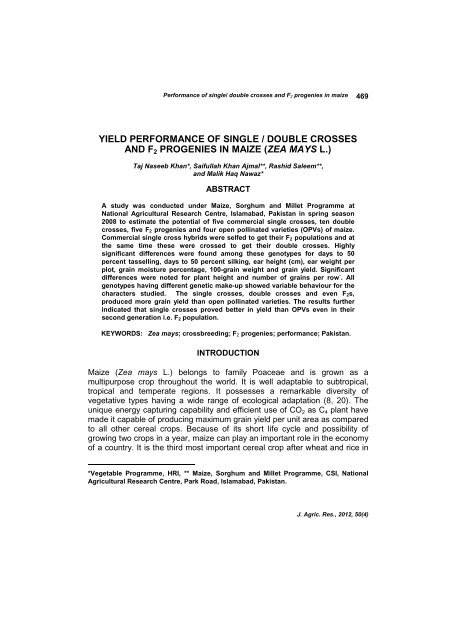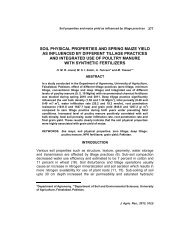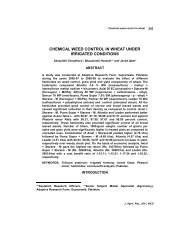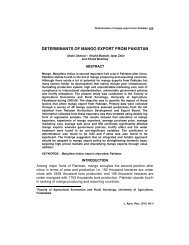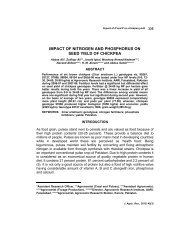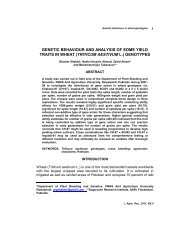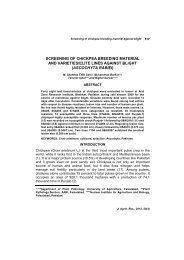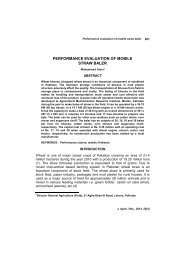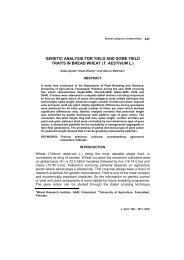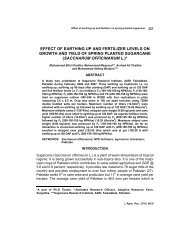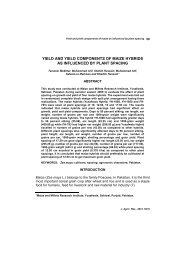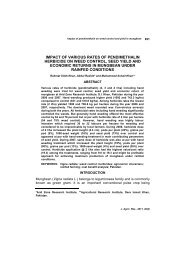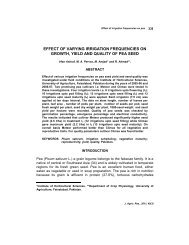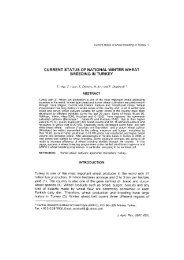yield performance of single / double crosses and f2 progenies in maize
yield performance of single / double crosses and f2 progenies in maize
yield performance of single / double crosses and f2 progenies in maize
Create successful ePaper yourself
Turn your PDF publications into a flip-book with our unique Google optimized e-Paper software.
Performance <strong>of</strong> <strong>s<strong>in</strong>gle</strong>/ <strong>double</strong> <strong>crosses</strong> <strong>and</strong> F 2 <strong>progenies</strong> <strong>in</strong> <strong>maize</strong><br />
469<br />
YIELD PERFORMANCE OF SINGLE / DOUBLE CROSSES<br />
AND F 2 PROGENIES IN MAIZE (ZEA MAYS L.)<br />
Taj Naseeb Khan*, Saifullah Khan Ajmal**, Rashid Saleem**,<br />
<strong>and</strong> Malik Haq Nawaz*<br />
ABSTRACT<br />
A study was conducted under Maize, Sorghum <strong>and</strong> Millet Programme at<br />
National Agricultural Research Centre, Islamabad, Pakistan <strong>in</strong> spr<strong>in</strong>g season<br />
2008 to estimate the potential <strong>of</strong> five commercial <strong>s<strong>in</strong>gle</strong> <strong>crosses</strong>, ten <strong>double</strong><br />
<strong>crosses</strong>, five F 2 <strong>progenies</strong> <strong>and</strong> four open poll<strong>in</strong>ated varieties (OPVs) <strong>of</strong> <strong>maize</strong>.<br />
Commercial <strong>s<strong>in</strong>gle</strong> cross hybrids were selfed to get their F 2 populations <strong>and</strong> at<br />
the same time these were crossed to get their <strong>double</strong> <strong>crosses</strong>. Highly<br />
significant differences were found among these genotypes for days to 50<br />
percent tassell<strong>in</strong>g, days to 50 percent silk<strong>in</strong>g, ear height (cm), ear weight per<br />
plot, gra<strong>in</strong> moisture percentage, 100-gra<strong>in</strong> weight <strong>and</strong> gra<strong>in</strong> <strong>yield</strong>. Significant<br />
differences were noted for plant height <strong>and</strong> number <strong>of</strong> gra<strong>in</strong>s per row - . All<br />
genotypes hav<strong>in</strong>g different genetic make-up showed variable behaviour for the<br />
characters studied. The <strong>s<strong>in</strong>gle</strong> <strong>crosses</strong>, <strong>double</strong> <strong>crosses</strong> <strong>and</strong> even F 2s,<br />
produced more gra<strong>in</strong> <strong>yield</strong> than open poll<strong>in</strong>ated varieties. The results further<br />
<strong>in</strong>dicated that <strong>s<strong>in</strong>gle</strong> <strong>crosses</strong> proved better <strong>in</strong> <strong>yield</strong> than OPVs even <strong>in</strong> their<br />
second generation i.e. F 2 population.<br />
KEYWORDS: Zea mays; crossbreed<strong>in</strong>g; F 2 <strong>progenies</strong>; <strong>performance</strong>; Pakistan.<br />
INTRODUCTION<br />
Maize (Zea mays L.) belongs to family Poaceae <strong>and</strong> is grown as a<br />
multipurpose crop throughout the world. It is well adaptable to subtropical,<br />
tropical <strong>and</strong> temperate regions. It possesses a remarkable diversity <strong>of</strong><br />
vegetative types hav<strong>in</strong>g a wide range <strong>of</strong> ecological adaptation (8, 20). The<br />
unique energy captur<strong>in</strong>g capability <strong>and</strong> efficient use <strong>of</strong> CO 2 as C 4 plant have<br />
made it capable <strong>of</strong> produc<strong>in</strong>g maximum gra<strong>in</strong> <strong>yield</strong> per unit area as compared<br />
to all other cereal crops. Because <strong>of</strong> its short life cycle <strong>and</strong> possibility <strong>of</strong><br />
grow<strong>in</strong>g two crops <strong>in</strong> a year, <strong>maize</strong> can play an important role <strong>in</strong> the economy<br />
<strong>of</strong> a country. It is the third most important cereal crop after wheat <strong>and</strong> rice <strong>in</strong><br />
*Vegetable Programme, HRI, ** Maize, Sorghum <strong>and</strong> Millet Programme, CSI, National<br />
Agricultural Research Centre, Park Road, Islamabad, Pakistan.<br />
J. Agric. Res., 2012, 50(4)
470<br />
T. N. Khan et al.<br />
Pakistan. It is grown on an area <strong>of</strong> 0.935 million hectares with an annual<br />
production <strong>of</strong> 3.262 million tons <strong>and</strong> average <strong>yield</strong> <strong>of</strong> 3488 kg per hectare (1).<br />
Maize is a short duration crop <strong>and</strong> has a top priority <strong>in</strong> hilly areas, especially<br />
<strong>in</strong> northern parts <strong>of</strong> the country. It is grown <strong>in</strong> temperate, tropical <strong>and</strong> subtropical<br />
areas <strong>and</strong> is used as gra<strong>in</strong> as well as fodder crop. It is also used <strong>in</strong><br />
bread mak<strong>in</strong>g, corn flakes, corn syrup, corn starch <strong>and</strong> <strong>in</strong> food <strong>and</strong> textile<br />
<strong>in</strong>dustry (11). Corn oil, an important by-product <strong>of</strong> <strong>maize</strong>, is the most suitable<br />
for human consumption due to low level <strong>of</strong> unsaturated fatty acids (10). The<br />
problem is that quality seed <strong>of</strong> improved <strong>maize</strong> genotypes, especially hybrid<br />
<strong>maize</strong> is not available. Currently, only 28-30 percent <strong>of</strong> <strong>maize</strong> area is under<br />
hybrids cultivation. In USA, synthetic varieties grown with high level<br />
production technology were replaced <strong>in</strong>itially by <strong>double</strong> cross hybrids <strong>and</strong><br />
then subsequently by <strong>s<strong>in</strong>gle</strong> cross hybrids <strong>and</strong> now almost 100 percent <strong>s<strong>in</strong>gle</strong><br />
cross hybrids. Therefore, these are giv<strong>in</strong>g 6-8 tons per hectare <strong>maize</strong> gra<strong>in</strong><br />
<strong>yield</strong>. In various central American environments, hybrids consistently<br />
out<strong>yield</strong>ed open poll<strong>in</strong>ated varieties (2). About 60-90 percent <strong>in</strong>crease <strong>in</strong><br />
<strong>maize</strong> <strong>yield</strong> <strong>in</strong> US corn belt has been attributed to hybrids development (3).<br />
So it is believed that dissem<strong>in</strong>ation, adoption <strong>and</strong> production <strong>of</strong> hybrid <strong>maize</strong><br />
will provide an effective <strong>and</strong> short term measure for boost<strong>in</strong>g <strong>maize</strong><br />
production <strong>in</strong> Pakistan.<br />
In countries like Pakistan where 65-70 percent area is under poorly<br />
perform<strong>in</strong>g l<strong>and</strong> races <strong>and</strong> varietal mixtures <strong>of</strong> <strong>maize</strong> with low use <strong>of</strong> <strong>in</strong>puts<br />
<strong>and</strong> poor technology, the prospects to uplift <strong>maize</strong> gra<strong>in</strong> <strong>yield</strong> is two folds.<br />
Maize hybrids are among the first ones, <strong>in</strong>troduced <strong>in</strong> the country <strong>in</strong> early<br />
fifties. Efforts were made <strong>in</strong> this direction <strong>and</strong> <strong>maize</strong> breeders produced<br />
several conventional hybrids based on US corn belt <strong>in</strong>bred l<strong>in</strong>es crossed with<br />
varieties <strong>and</strong> <strong>in</strong>bred l<strong>in</strong>es derived from local material. These hybrids had<br />
greater adaptability <strong>and</strong> high <strong>yield</strong> potential. However, lack <strong>of</strong> an appropriate<br />
local seed <strong>in</strong>dustry resulted <strong>in</strong> little diffusion <strong>of</strong> these genotypes at farm level<br />
<strong>and</strong> thus emphasis was shifted to develop improved open poll<strong>in</strong>ated varieties<br />
(OPVs). Dur<strong>in</strong>g mid seventies, public-private sectors collaboration <strong>in</strong>troduced<br />
spr<strong>in</strong>g <strong>maize</strong> hybrid technology <strong>in</strong> Punjab, which ultimately led to the most<br />
successful cultivation <strong>of</strong> <strong>maize</strong> <strong>in</strong> the country – the spr<strong>in</strong>g hybrid <strong>maize</strong><br />
cultivation. The greater <strong>in</strong>volvement <strong>of</strong> private sector, especially mult<strong>in</strong>ational<br />
seed companies, has turned hybrid <strong>maize</strong> <strong>in</strong>to a multi-billion <strong>in</strong>dustry.<br />
The spr<strong>in</strong>g <strong>maize</strong> production <strong>in</strong> Pakistan has become the most productive<br />
sector for agricultural production. The development <strong>and</strong> adoption <strong>of</strong> <strong>maize</strong><br />
hybrids, dur<strong>in</strong>g both spr<strong>in</strong>g <strong>and</strong> autumn seasons <strong>in</strong> Pakistan, can lead to a<br />
J. Agric. Res., 2012, 50(4)
Performance <strong>of</strong> <strong>s<strong>in</strong>gle</strong>/ <strong>double</strong> <strong>crosses</strong> <strong>and</strong> F 2 <strong>progenies</strong> <strong>in</strong> <strong>maize</strong><br />
471<br />
breakthrough for <strong>in</strong>creas<strong>in</strong>g <strong>maize</strong> productivity on susta<strong>in</strong>able basis. The<br />
hybrids available <strong>in</strong> Pakistan are generally marketed by the mult<strong>in</strong>ational<br />
companies whereas the improved open poll<strong>in</strong>ated varieties be<strong>in</strong>g planted by<br />
farmers come from the public sector organizations. The price <strong>of</strong> commercial<br />
hybrids is not affordable by the farm<strong>in</strong>g community. Therefore, farmers prefer<br />
to cultivate open poll<strong>in</strong>ated varieties. Hybrids generally have higher <strong>yield</strong><br />
potential than open poll<strong>in</strong>ated varieties. The use <strong>of</strong> hybrids is a major source<br />
to maximize per hectare <strong>yield</strong> <strong>in</strong> <strong>maize</strong>. Hybrid <strong>maize</strong> has long ears, more<br />
gra<strong>in</strong> rows per ear <strong>and</strong> greater gra<strong>in</strong> <strong>yield</strong> than open poll<strong>in</strong>ated cultivars (16).<br />
In present study, commercial <strong>s<strong>in</strong>gle</strong> cross hybrids, their <strong>double</strong> cross hybrids<br />
<strong>and</strong> selfed hybrids (F 2 <strong>progenies</strong> <strong>of</strong> commercial hybrids) were compared with<br />
open poll<strong>in</strong>ated varieties to assess their relative <strong>performance</strong> <strong>in</strong> terms <strong>of</strong><br />
<strong>yield</strong>.<br />
MATERIALS AND METHODS<br />
Five commercial <strong>s<strong>in</strong>gle</strong> cross hybrids were sown under Maize, Sorghum <strong>and</strong><br />
Millet Programme at National Agricultural Research Centre, Islamabad,<br />
Pakistan <strong>in</strong> spr<strong>in</strong>g season 2008. At the time <strong>of</strong> flower<strong>in</strong>g, these hybrids were<br />
crossed to get ten <strong>double</strong> cross hybrids <strong>and</strong> selfed to get five F 2 <strong>progenies</strong>.<br />
The seed from <strong>double</strong> <strong>crosses</strong> <strong>and</strong> F 2 <strong>progenies</strong> was harvested <strong>and</strong> sown<br />
aga<strong>in</strong> <strong>in</strong> the autumn season 2008. The seed <strong>of</strong> all these genotypes alongwith<br />
four open poll<strong>in</strong>ated varieties (Table 1) was sown <strong>in</strong> RCBD with two<br />
replications. The experimental unit was 5 meter long with plant to plant<br />
distance <strong>of</strong> 25 cm <strong>and</strong> row to row distance <strong>of</strong> 75 cm. F<strong>in</strong>al plant st<strong>and</strong> was<br />
21 plants per row. NPK fertilizers were applied @ 87-46-50 kg per hectare.<br />
All P <strong>and</strong> K while 1 / 3 <strong>of</strong> N were applied dur<strong>in</strong>g seed bed preparation. The<br />
second dose <strong>of</strong> N was applied at 50 cm plant height <strong>and</strong> third dose was given<br />
before tassel emergence. The <strong>in</strong>secticide i.e. Furadon (granular) was applied<br />
@ 20 kg per hectare after one month <strong>of</strong> crop emergence to control stem<br />
borers. All other cultural practices were applied uniformly when needed. The<br />
data were collected for biometric plant traits viz. days to 50 percent tassell<strong>in</strong>g,<br />
days to 50 percent silk<strong>in</strong>g, plant height, ear height, ear weight per plot, gra<strong>in</strong><br />
moisture percentage, number <strong>of</strong> gra<strong>in</strong> rows per ear, number <strong>of</strong> gra<strong>in</strong>s per<br />
row, 100-gra<strong>in</strong> weight <strong>and</strong> gra<strong>in</strong> <strong>yield</strong>. The analysis <strong>of</strong> variance was<br />
conducted accord<strong>in</strong>g to Steel <strong>and</strong> Torrie (18) to observe the statistical<br />
significance among all plant characters. Duncan’s multiple range (DMR) test<br />
was applied for comparison between mean values <strong>of</strong> various plant attributes.<br />
J. Agric. Res., 2012, 50(4)
472<br />
T. N. Khan et al.<br />
Table 1.<br />
Maize genotypes (<strong>s<strong>in</strong>gle</strong> <strong>crosses</strong>, <strong>double</strong> <strong>crosses</strong>, F 2s <strong>and</strong> OPVs) <strong>in</strong>cluded <strong>in</strong><br />
the study dur<strong>in</strong>g 2008.<br />
S.<br />
No<br />
.<br />
Genotypes Status S.<br />
No.<br />
Genotypes<br />
Status<br />
1 6535 S<strong>in</strong>gle Cross 13 ZR-123 × MS-259 Double Cross<br />
2 ZR-123 S<strong>in</strong>gle Cross 14 ZR-123 × EA-6802 Double Cross<br />
3 EA-6802 S<strong>in</strong>gle Cross 15 ZR-123 × Hicorn-8464 Double Cross<br />
4 MS-259 S<strong>in</strong>gle Cross 16 EV-3001 OPV<br />
5 Hicorn-8464 S<strong>in</strong>gle Cross 17 Agaiti-2002 OPV<br />
6 6535 × ZR-123 Double Cross 18 EV-6089 (Ch<strong>and</strong>ni) OPV<br />
7 6535 × EA-6802 Double Cross 19 Sahiwal-2002 OPV<br />
8 6535xHicorn 8464 Double Cross 20 6535 × 6535 F 2<br />
9 6535 × MS-259 Double Cross 21 ZR-123 × ZR-123 F 2<br />
10 EA-6802× MS-259 Double Cross 22 EA-6802 × EA-6802 F 2<br />
11 EA-6802 × Double Cross 23 MS-259 × MS-259 F 2<br />
Hicorn-8464<br />
12 MS-259 × Hicorn-<br />
8464<br />
Double Cross 24 Hicorn-8464 x<br />
Hicorn-8464<br />
F 2<br />
RESULTS AND DISCUSSION<br />
Highly significant differences among genotypes were observed for all<br />
characters studied except for number <strong>of</strong> gra<strong>in</strong> rows per ear (Table 2). It<br />
<strong>in</strong>dicated the existence <strong>of</strong> genetic variability for effective future breed<strong>in</strong>g<br />
programme. Significant results for plant height, ear height, ear length, ear<br />
diameter <strong>and</strong> gra<strong>in</strong> <strong>yield</strong> agree to the f<strong>in</strong>d<strong>in</strong>gs <strong>of</strong> Rafique et al. (12).<br />
Table 2.<br />
Mean square value <strong>of</strong> some metric traits <strong>in</strong> <strong>maize</strong>.<br />
Source <strong>of</strong><br />
variation<br />
DF<br />
Days to<br />
50%<br />
tessell<strong>in</strong>g<br />
Days to<br />
50%<br />
silk<strong>in</strong>g<br />
Plant<br />
height (cm)<br />
Ear<br />
height<br />
(cm)<br />
Ear weight/plot<br />
(kg)<br />
Replication 1 2.083 2.521 16.45.021 111.203 0.007<br />
Genotypes 23 7.174** 6.847** 445.948* 261.820* 42.911**<br />
Error 23 1.170 1.738 204.89 61.456 0.142<br />
Gra<strong>in</strong><br />
moisture<br />
(%)<br />
No. <strong>of</strong><br />
gra<strong>in</strong><br />
rows/ear<br />
No. <strong>of</strong><br />
gra<strong>in</strong>s/row<br />
100-gra<strong>in</strong><br />
wt.(g)<br />
Gra<strong>in</strong> <strong>yield</strong><br />
(t/ha)<br />
1.857 2.083 10.083 0.003 86755.915<br />
10.499** 4.402 ns 36.431* 18.078** 29726204.832**<br />
1.376 2.431 15.736 0.055 58212.255<br />
The data also revealed highly significant differences for most <strong>of</strong> the traits<br />
(Table 3). Maximum days to 50 percent tassell<strong>in</strong>g were noted <strong>in</strong> F 2 population<br />
<strong>of</strong> <strong>s<strong>in</strong>gle</strong> cross MS-259 (57.50 days) followed by <strong>double</strong> <strong>crosses</strong> ZR-123 ×<br />
J. Agric. Res., 2012, 50(4)
Performance <strong>of</strong> <strong>s<strong>in</strong>gle</strong>/ <strong>double</strong> <strong>crosses</strong> <strong>and</strong> F 2 <strong>progenies</strong> <strong>in</strong> <strong>maize</strong><br />
473<br />
MS-259 <strong>and</strong> MS-259 × Hicorn-8464 (55.5 days each). S<strong>in</strong>gle cross 6535 <strong>and</strong><br />
<strong>double</strong> cross EA-6802 × Hicorn-8464 took m<strong>in</strong>imum days to tassell<strong>in</strong>g (49.5<br />
days each). All other genotypes showed variable behavior <strong>in</strong>dicat<strong>in</strong>g early to<br />
late tassell<strong>in</strong>g between 50 <strong>and</strong> 55 days. These results are supported by some<br />
earlier workers (6, 9). Maximum days to 50 percent silk<strong>in</strong>g were recorded <strong>in</strong><br />
F 2 <strong>of</strong> <strong>s<strong>in</strong>gle</strong> cross MS-259 (60 days) followed by <strong>s<strong>in</strong>gle</strong> cross Hicorn-8464<br />
<strong>and</strong> <strong>double</strong> cross ZR-123 × MS-259 (58.5 days each) (Table 3). M<strong>in</strong>imum<br />
days (52) were taken by <strong>s<strong>in</strong>gle</strong> cross 6535 <strong>and</strong> <strong>double</strong> cross EA-6802 ×<br />
Hicorn-8464. All other genotypes took 55 <strong>and</strong> 58 days for this trait.<br />
Obviously, the genotypes <strong>of</strong> diversified nature did not show any particular<br />
effect <strong>in</strong> silk<strong>in</strong>g also. The present f<strong>in</strong>d<strong>in</strong>gs are <strong>in</strong> accordance with those<br />
reported earlier (4, 7).<br />
The data perta<strong>in</strong><strong>in</strong>g to plant height also showed significant differences among<br />
genotypes (Table 3). Maximum plant height (196 cm) was atta<strong>in</strong>ed by open<br />
poll<strong>in</strong>ated variety Ch<strong>and</strong>ni followed by <strong>s<strong>in</strong>gle</strong> cross ZR-123 (195.50 cm). The<br />
<strong>s<strong>in</strong>gle</strong> cross 6535 showed the lowest height (140.50 cm). Plant height <strong>in</strong><br />
other genotypes ranged from 142 to 189 cm. The plant height <strong>of</strong> <strong>s<strong>in</strong>gle</strong><br />
<strong>crosses</strong>, <strong>double</strong> <strong>crosses</strong> <strong>and</strong> OPVs was generally greater than F 2 populations<br />
<strong>of</strong> <strong>s<strong>in</strong>gle</strong> <strong>crosses</strong> EA-6802, Hicorn-8464 <strong>and</strong> 6535 except the <strong>s<strong>in</strong>gle</strong> cross<br />
6535. Similar results have been reported by previous workers (5,6,19).<br />
Open poll<strong>in</strong>ated varieties Ch<strong>and</strong>ni <strong>and</strong> Sahiwal-2002 showed maximum ear<br />
height (92.50 <strong>and</strong> 92.00 cm), followed by variety EV-3001 (83.50 cm). The<br />
<strong>s<strong>in</strong>gle</strong> cross 6535 showed the lowest ear height (45.20 cm). All other<br />
genotypes showed ear height rang<strong>in</strong>g from 54.63 to 77.50 cm except <strong>s<strong>in</strong>gle</strong><br />
cross ZR-123 (80.60 cm) (Table 3). Open poll<strong>in</strong>ated varieties were prom<strong>in</strong>ent<br />
<strong>in</strong> this trait whereas all other genotypes did not show any particular<br />
difference. Similar results have been reported earlier (7, 9, 14, 19).<br />
The <strong>s<strong>in</strong>gle</strong> cross MS-259 gave the highest ear weight per plot (20.15 kg)<br />
followed by <strong>double</strong> cross 6535 × MS-259 (19.67 kg) <strong>and</strong> <strong>s<strong>in</strong>gle</strong> cross 6535<br />
(18.45 kg) (Table 3). The open poll<strong>in</strong>ated varieties Ch<strong>and</strong>ni ‘EV-6089’, Agaiti-<br />
2007, EV-3001 <strong>and</strong> Sahiwal-2002 gave the lowest ear weight per plot i.e.<br />
5.37, 6.09, 7.53 <strong>and</strong> 10.04 kg, respectively. All other genotypes gave<br />
<strong>in</strong>termediate <strong>performance</strong> with 11.24 kg to 18.05 kg ear weight per plot. F 2 s<br />
rema<strong>in</strong>ed beh<strong>in</strong>d the <strong>s<strong>in</strong>gle</strong> <strong>and</strong> <strong>double</strong> <strong>crosses</strong> with respect to ear weight but<br />
surpassed open poll<strong>in</strong>ated varieties (13, 17).<br />
Maximum gra<strong>in</strong> moisture percentage was observed <strong>in</strong> <strong>double</strong> cross ZR-123 ×<br />
MS-259 (33.60) whereas majority <strong>of</strong> <strong>s<strong>in</strong>gle</strong> <strong>crosses</strong> <strong>and</strong> <strong>double</strong> <strong>crosses</strong><br />
showed non-significant difference <strong>in</strong> this trait (Table 3). Out <strong>of</strong> 24 genotypes,<br />
J. Agric. Res., 2012, 50(4)
474<br />
T. N. Khan et al.<br />
J. Agric. Res., 2012, 50(4)
Performance <strong>of</strong> <strong>s<strong>in</strong>gle</strong>/ <strong>double</strong> <strong>crosses</strong> <strong>and</strong> F 2 <strong>progenies</strong> <strong>in</strong> <strong>maize</strong><br />
475<br />
21 showed non-significant differences for gra<strong>in</strong> moisture percentage. Hussa<strong>in</strong><br />
et al. (6) also reported variation <strong>in</strong> gra<strong>in</strong> moisture level <strong>in</strong> <strong>maize</strong> hybrids. The<br />
lowest gra<strong>in</strong> moisture was noted <strong>in</strong> variety Agaiti-2002 (23.45%) <strong>and</strong> EV-<br />
3001 (25.95%). The moisture contents <strong>of</strong> all other F 2 s were lower than the<br />
<strong>s<strong>in</strong>gle</strong> <strong>and</strong> <strong>double</strong> <strong>crosses</strong> (Table 3). These results agree to those <strong>of</strong> Ihsan et<br />
al. (7) <strong>and</strong> Rehman et al (13). For gra<strong>in</strong>s rows per ear, <strong>s<strong>in</strong>gle</strong> <strong>crosses</strong> MS-<br />
259, 6535, open poll<strong>in</strong>ated variety Sahiwal-2002 <strong>and</strong> <strong>double</strong> cross 6535 ×<br />
MS-259 ranked first (17 rows each). All other genotypes had 13 to 16 number<br />
<strong>of</strong> gra<strong>in</strong> rows per ear (Table 3).<br />
Open poll<strong>in</strong>ated variety EV-3001 topped <strong>in</strong> number <strong>of</strong> gra<strong>in</strong>s per row (44.0)<br />
followed by <strong>s<strong>in</strong>gle</strong> cross ZR-123 (42.0) (Table 3). The lowest number <strong>of</strong><br />
gra<strong>in</strong>s per row (28.50) was recorded <strong>in</strong> F 2 <strong>of</strong> <strong>s<strong>in</strong>gle</strong> cross ZR-123. F 2 <strong>and</strong> few<br />
<strong>double</strong> <strong>crosses</strong> had lower number <strong>of</strong> gra<strong>in</strong>s per row. Shahwani et al. (15)<br />
also reported similar results.<br />
Maximum 100-gra<strong>in</strong> weight (28.76 g) was recorded <strong>in</strong> <strong>s<strong>in</strong>gle</strong> cross MS-259<br />
followed by <strong>double</strong> cross 6535 × MS-259 (27.93 g). The lowest 100-gra<strong>in</strong><br />
weight was observed <strong>in</strong> variety EV-6089 (18.67 g) (Table 3). These results<br />
are supported by some earlier scientists (7, 9).<br />
S<strong>in</strong>gle cross MS-259 excelled <strong>in</strong> gra<strong>in</strong> <strong>yield</strong> (22.19 t/ha) followed by <strong>double</strong><br />
cross 6535 × MS-259 <strong>and</strong> <strong>s<strong>in</strong>gle</strong> cross 6535 (15.73 t). The <strong>yield</strong> <strong>of</strong> two<br />
<strong>double</strong> <strong>crosses</strong> ZR-123 × Hicorn-8464 <strong>and</strong> EA-6802 × MS-259 was<br />
statistically at par with <strong>s<strong>in</strong>gle</strong> <strong>crosses</strong> 6535 <strong>and</strong> EA-6802. F 2 <strong>progenies</strong> <strong>of</strong><br />
<strong>s<strong>in</strong>gle</strong> <strong>crosses</strong> ZR-123 <strong>and</strong> 6535 <strong>yield</strong>ed statistically similar to <strong>s<strong>in</strong>gle</strong> cross<br />
<strong>and</strong> <strong>double</strong> cross hybrids. Open poll<strong>in</strong>ated variety EV-6089 (Ch<strong>and</strong>ni)<br />
<strong>yield</strong>ed the lowest (4.89 t/ha) The F 2 s <strong>of</strong> <strong>s<strong>in</strong>gle</strong> <strong>crosses</strong> MS-29, Hicorn-8464<br />
<strong>and</strong> ZR-123 gave more <strong>yield</strong> than all open poll<strong>in</strong>ated varieties, whereas other<br />
genotypes gave <strong>in</strong>termediate <strong>performance</strong>. These results agree to those <strong>of</strong><br />
Souza et al. (17).<br />
REFERENCES<br />
1. Anon. 2010. Economic Survey <strong>of</strong> Pakistan. Statistics Division,<br />
Islamabad. p. 21.<br />
2. Bolanos, J. 1995. Physiological basis for <strong>yield</strong> difference <strong>in</strong> selected<br />
<strong>maize</strong> cultivars from Central America. Field Crops Res. 42: 69-80.<br />
3. Duvick, D. N. 1984. Genetic contribution to <strong>yield</strong> ga<strong>in</strong> <strong>of</strong> US Hybrid<br />
<strong>maize</strong>. In: Genetic Contribution to Yield Ga<strong>in</strong>s <strong>of</strong> Five Major Crops.<br />
Fehr, W. R. (ed). CSSA Spec. Pub. 7. CSSA, Medion, USA.<br />
4. Hussa<strong>in</strong>, N., K. Hayat, F. U. Khan, A. Aziz <strong>and</strong> Q. Zaman. 2003.<br />
Evaluation <strong>of</strong> different <strong>maize</strong> varieties under agro-ecological conditions<br />
<strong>of</strong> D. I. Khan. Sarhad J. Agric. 19(4): 539-542.<br />
J. Agric. Res., 2012, 50(4)
476<br />
T. N. Khan et al.<br />
5. Hussa<strong>in</strong>, N., K. Hayat, M. Zubair, Q. Zaman <strong>and</strong> A. Aziz. 2005.<br />
Adaptability <strong>of</strong> <strong>maize</strong> varieties to D.I. Khan ecology. Indus J. Pl. Sci.<br />
4(2): 191-195.<br />
6. Hussa<strong>in</strong>, N., M.S. Baloch, Q. Zaman, A. Aziz <strong>and</strong> G. Sadozai. 2010.<br />
Adaptability <strong>and</strong> genetic variation <strong>in</strong> some <strong>maize</strong> hybrids. J. Agric. Res.<br />
48(4): 437-443.<br />
7. Ihsan, H., I. H. Khalil, H. Rahman <strong>and</strong> M. Iqbal. 2005. Genotypic<br />
variability for morphological <strong>and</strong> reproductive traits among exotic <strong>maize</strong><br />
hybrid. Sarhad J. Agric. 21 (4): 599-602.<br />
8. Karunaratne, K. M. 2001. Varietal development <strong>and</strong> productivity<br />
enhancement <strong>of</strong> hybrid <strong>maize</strong> <strong>in</strong> Sri Lanka. Annals <strong>of</strong> the Sri Lanka<br />
Dept. Agric. 3: 79-80.<br />
9. Khan, A., H. Rehman, F. Ahmad <strong>and</strong> H. Khan. 2002. Evaluation <strong>of</strong><br />
<strong>maize</strong> synthetics for maturity <strong>and</strong> <strong>yield</strong> under Haripur conditions.<br />
Sarhad J. Agric. 18 (3): 299-302.<br />
10. Khan, K. H. <strong>and</strong> S. A. Khan. 1982. Fatty acids consumption <strong>of</strong> <strong>maize</strong><br />
germ oil varietal difference. Pak. J. Sci. 24: 21-23.<br />
11. Morris, M., J. Risopoulos <strong>and</strong> D. Beck. 1999. Genetic change <strong>in</strong><br />
farmer-recycled <strong>maize</strong> seed: A review <strong>of</strong> the evidence. Work<strong>in</strong>g Paper<br />
99-07, CIMMYT. p. 28-30.<br />
12. Rafique, M., A. Hussa<strong>in</strong> <strong>and</strong> M. Altaf. 2011. Inheritance studies <strong>of</strong><br />
some measurable traits <strong>in</strong> <strong>maize</strong> (Zea mays L.). J. Agric. Res. 49(3):<br />
313-318.<br />
13. Rehman, H., F. Raziq <strong>and</strong> S. Ahmed. 2005. Screen<strong>in</strong>g <strong>and</strong> evaluation<br />
<strong>of</strong> <strong>maize</strong> genotypes for southern leaf blight resistant <strong>and</strong> <strong>yield</strong><br />
<strong>performance</strong>. Sarhad J. Agric. 21 (2): 231-235.<br />
14. Russel, W. A. 1984. Agronomic <strong>performance</strong> <strong>of</strong> cultivars represent<strong>in</strong>g<br />
different years <strong>of</strong> breed<strong>in</strong>g. Maydica. 29 : 375-390.<br />
15. Shahwani, M.N., A. Salarzi, B.A. Bangulzai, M.A. Shahwa<strong>in</strong> <strong>and</strong> N.M.<br />
Megal. 2001. Hybrid vigor for gra<strong>in</strong> <strong>yield</strong> <strong>and</strong> its components <strong>in</strong> <strong>maize</strong><br />
<strong>crosses</strong>. Sarhad J. Agric. 17: 571-576.<br />
16. Sleper, D. A. <strong>and</strong> J. M. Poehlman. 2006. Breed<strong>in</strong>g Field Crops. The<br />
Blackwell Publish<strong>in</strong>g Inc. Ames, Iowa, USA.<br />
17. Souza, F. R. S. de, R. H. E. Rebeiro <strong>and</strong> L. A Veloso. 2002. Yield<strong>in</strong>g<br />
<strong>and</strong> phenotypic stability <strong>of</strong> corn cultivars <strong>in</strong> three municipal districts <strong>of</strong><br />
Para State, Brazil. Pesquisa-Agrepercuria-Brasileira. 37: 1269-1274.<br />
18. Steel, R.G. D. <strong>and</strong> J. H. Torrie. 1980. Pr<strong>in</strong>ciples <strong>and</strong> Procedures <strong>of</strong><br />
Statistics: A Biometrical Approach. 2nd Ed. McGraw-Hill Book Co.,<br />
Inc., New York<br />
19. Ullah, I., H. Khalil, H. Ullah <strong>and</strong> J. Khan. 2005. Comparative<br />
<strong>performance</strong> <strong>of</strong> F 1 <strong>maize</strong> hybrids across seasons. Sarhad J. Agric.<br />
21(3): 395-402.<br />
20. Zamir, M. S. I., A. H. Ahmed, H.M.R. Javed <strong>and</strong> T. Latif. 2011. Growth<br />
<strong>and</strong> <strong>yield</strong> behaviour <strong>of</strong> two <strong>maize</strong> hybrids towards different plant<br />
spac<strong>in</strong>gs. Cercetări Agronomice în Moldova. Vol. XLIV, No. 2<br />
(146):33-40.<br />
J. Agric. Res., 2012, 50(4)


